Optimal Grab Bar Placement for In-Home Senior Bathrooms Adapted from CMHC Research

Falls in the bathroom can cause injuries, sometimes fatal. Entering and exiting a slippery bathtub poses a significant fall risk that can be mitigated with grab bars. While commonly installed throughout homes, grab bars are often placed without considering optimal support.
CMHC Study
A study by the University of Ottawa, in partnership with CMHC, evaluated the safety and effectiveness of five different bathtub grab bar configurations. Researchers tested these configurations with 103 seniors, aged 70 on average, in a controlled environment.
Study Setup
- Participants: Seniors living in their own homes.
- Testing Environment: The Occupational Therapy laboratory at the University of Ottawa.
- Evaluation Criteria: Participants ranked each configuration based on safety, ease of use, comfort, and helpfulness.
Grab Bar Configurations
Canadian Standards Association (CSA)
- Horizontal bar (120 cm) on the back wall, 18 cm above the rim.
- Vertical bar (120 cm) on the faucet wall, also 18 cm above the rim.

U.S. Uniform Accessibility Standards (UFAS)
- Four horizontal bars.
- Back wall: Two bars (82 cm each), positioned 23 cm and 48 cm above the rim.
- Faucet and opposite walls: One bar (61 cm) each, 48 cm above the rim.

Ontario Building Code (OBC) Modified
- L-shaped bar on the back wall (each side 75 cm).
- Horizontal section: 17 cm above the rim.
- Vertical section: 38 cm from the faucet wall.

Ottawa-Carleton Common (OCC)
- Angled back wall bar: Lowest point 23 cm above the rim, 74 cm from the faucet wall.
- Vertical bar (120 cm) on the faucet wall, 18 cm above the rim.

All Bars
- A combination of the CSA, UFAS, OBC Modified, and OCC configurations.

Study Results
Participant Demographics
- 64.1% did not have grab bars installed at home.
- 78.4% of those with grab bars used them regularly.
- Only 11 participants had two or more bars, despite this being the minimum recommended.
Configuration Rankings
| Rank | Configuration | Key Features | Effectiveness | Feedback Highlights |
| 1 | All Bars | Combination of all configurations; most versatile | High | Highly preferred; supports all actions effectively |
| 2 | Ottawa-Carleton Common (OCC) | Diagonal back wall bar; vertical faucet wall bar | High | Effective for entering and exiting the tub |
| 3 | U.S. Uniform Accessibility Standards (UFAS) | Four horizontal bars around the tub | Moderate | Useful for standing up and balance |
| 4 | Canadian Standards Association (CSA) | Horizontal and vertical bars on adjacent walls | Low | Limited support; low positioning issues |
| 5 | Ontario Building Code (OBC) | L-shaped bar on back wall | Low | Ineffective for getting out of the tub |
The CSA and OBC configurations were less effective, with participants noting issues like low positioning and limited support.
The OCC and All Bars configurations were favoured for entering and exiting the tub.
Usage Observations
- Entering the Tub: OCC (68.8%) and All Bars were most used.
- Sitting Down: No significant differences, but CSA ranked highest (87.3%).
- Standing Up: UFAS was used most often (86.3%).
- Exiting the Tub: OCC (62.7%) was preferred.
Additional Supports:
- 99% of participants used other supports, such as walls (42.2%) and the tub rim (99%).
Ideal Configurations
When asked to design their ideal setup:
- 40% wanted two bars (vertical on the faucet wall and horizontal/angled on the back wall).
- 22.6% preferred three bars (back, faucet, and head walls).
- 20% suggested a bar on the tub rim.
Recommendations
- Install a minimum of two grab bars
- Vertical bar on the faucet wall for entering and exiting
- Horizontal or angled bar on the back wall for sitting and standing
- Consider a second horizontal bar on the faucet wall to extend beyond the tub’s edge
- Adjust the horizontal or angled bar on the back wall to user needs
- Incorporate non-slip surfaces in bathtubs
- For new construction, reinforce back and faucet walls for grab bar installation
Grab Bars in Toilet Stall Requirements:
Side Wall – The side wall grab bar shall be 42 inches (1065 mm) long minimum, located 12 inches (305 mm) maximum from the rear wall and extending 54 inches (1370 mm) minimum from the rear wall.
Rear Wall – The rear wall grab bar shall be 36 inches (915 mm) long minimum and extend from the centerline of the water closet 12 inches (305 mm) minimum on one side and 24 inches (610 mm) minimum on the other side.
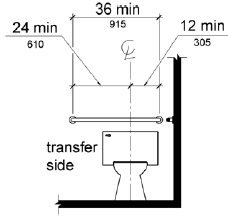
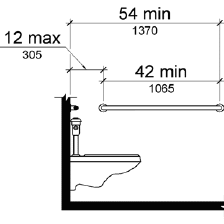
EXCEPTIONS: 1. The rear grab bar shall be permitted to be 24 inches (610 mm) long minimum, centred on the water closet, where wall space does not permit a length of 36 inches (915 mm) minimum due to the location of a recessed fixture adjacent to the water closet.
Grab Bars in Shower Stall Requirements
Transfer Type Shower Compartments – Transfer type shower compartments shall be 36 inches (915 mm) by 36 inches (915 mm) clear inside dimensions measured at the centre points of opposing sides and shall have a 36 inch (915 mm) wide minimum entry on the face of the shower compartment. Clearance of 36 inches (915 mm) wide minimum by 48 inches (1220 mm) long minimum measured from the control wall shall be provided.
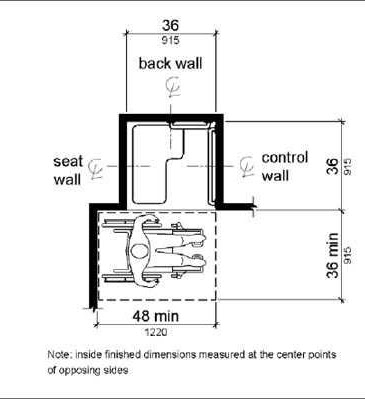
Standard Roll-In Type Shower Compartments – Standard roll-in type shower compartments shall be 30 inches (760 mm) wide minimum by 60 inches (1525 mm) deep minimum clear inside dimensions measured at center points of opposing sides and shall have a 60 inches (1525 mm) wide minimum entry on the face of the shower compartment.
608.2.2.1 Clearance. A 30 inch (760 mm) wide minimum by 60 inch (1525 mm) long minimum clearance shall be provided adjacent to the open face of the shower compartment.
EXCEPTION: A lavatory complying with 606 shall be permitted on one 30 inch (760 mm) wide minimum side of the clearance provided that it is not on the side of the clearance adjacent to the controls or, where provided, not on the side of the clearance adjacent to the shower seat.
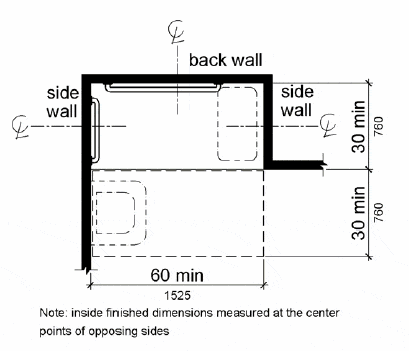
Alternate Roll-In Type Shower Compartments – Alternate roll-in type shower compartments shall be 36 inches (915 mm) wide and 60 inches (1525 mm) deep minimum clear inside dimensions measured at centre points of opposing sides. A 36 inch (915 mm) wide minimum entry shall be provided at one end of the long side of the compartment.
608.3 Grab Bars – Grab bars shall comply with 609 and shall be provided in accordance with 608.3. Where multiple grab bars are used, required horizontal grab bars shall be installed at the same height above the finish floor.
EXCEPTIONS:
1. Grab bars shall not be required to be installed in a shower located in a bathing facility for a single occupant accessed only through a private office, and not for common use or public use provided that reinforcement has been installed in walls and located so as to permit the installation of grab bars complying with 608.3.
2. In residential dwelling units, grab bars shall not be required to be installed in showers located in bathing facilities provided that reinforcement has been installed in walls and located so as to permit the installation of grab bars complying with 608.3.
Transfer Type Shower Compartments – In transfer type compartments, grab bars shall be provided across the control wall and back wall to a point 18 inches (455 mm) from the control wall.

Alternate Roll-In Type Shower Compartments – In alternate roll-in type shower compartments, grab bars shall be provided on the back wall and the side wall farthest from the compartment entry. Grab bars shall not be provided above the seat. Grab bars shall be installed 6 inches (150 mm) maximum from adjacent walls.
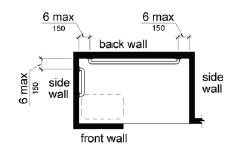
608.4 Seats. A folding or non-folding seat shall be provided in transfer type shower compartments. A folding seat shall be provided in roll-in type showers required in transient lodging guest rooms with mobility features complying with 806.2. Seats shall comply with 610.
Bathtubs With Permanent Seats
Back Wall. Two grab bars shall be installed on the back wall, one located in accordance with 609.4 and the other located 8 inches (205 mm) minimum and 10 inches (255 mm) maximum above the rim of the bathtub. Each grab bar shall be installed 15 inches (380 mm) maximum from the head end wall and 12 inches (305 mm) maximum from the control end wall.
Control End Wall. A grab bar 24 inches (610 mm) long minimum shall be installed on the control end wall at the front edge of the bathtub.

Bathtubs Without Permanent Seats
Back Wall. Two grab bars shall be installed on the back wall, one located in accordance with 609.4 and other located 8 inches (205 mm) minimum and 10 inches (255 mm) maximum above the rim of the bathtub. Each grab bar shall be 24 inches (610 mm) long minimum and shall be installed 24 inches (610 mm) maximum from the head end wall and 12 inches (305 mm) maximum from the control end wall.
Control End Wall. A grab bar 24 inches (610 mm) long minimum shall be installed on the control end wall at the front edge of the bathtub.
Head End Wall. A grab bar 12 inches (305 mm) long minimum shall be installed on the head end wall at the front edge of the bathtub.
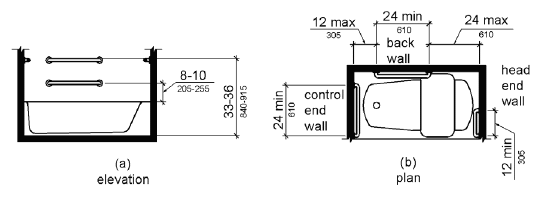
Controls, other than drain stoppers, shall be located on an end wall. Controls shall be between the bathtub rim and grab bar, and between the open side of the bathtub and the centre line of the width of the bathtub. Controls shall comply with 309.4.
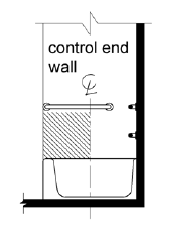
Installing Grab Bars
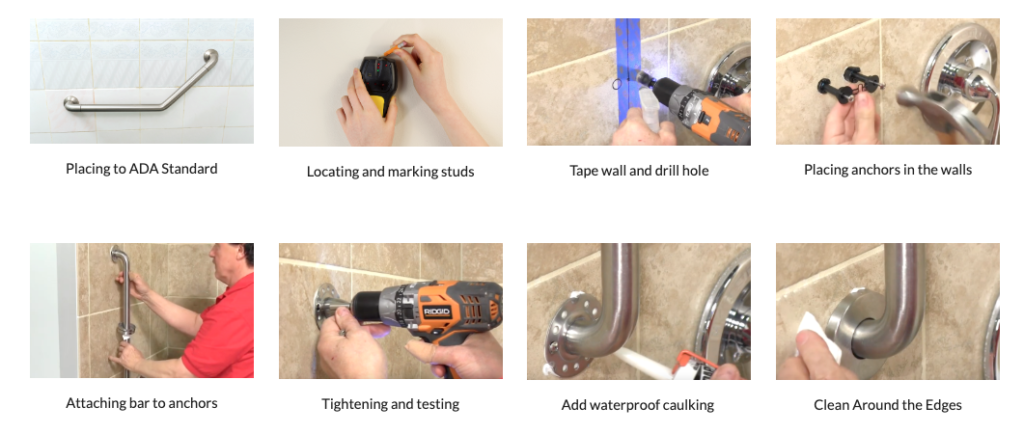
Tools and Materials
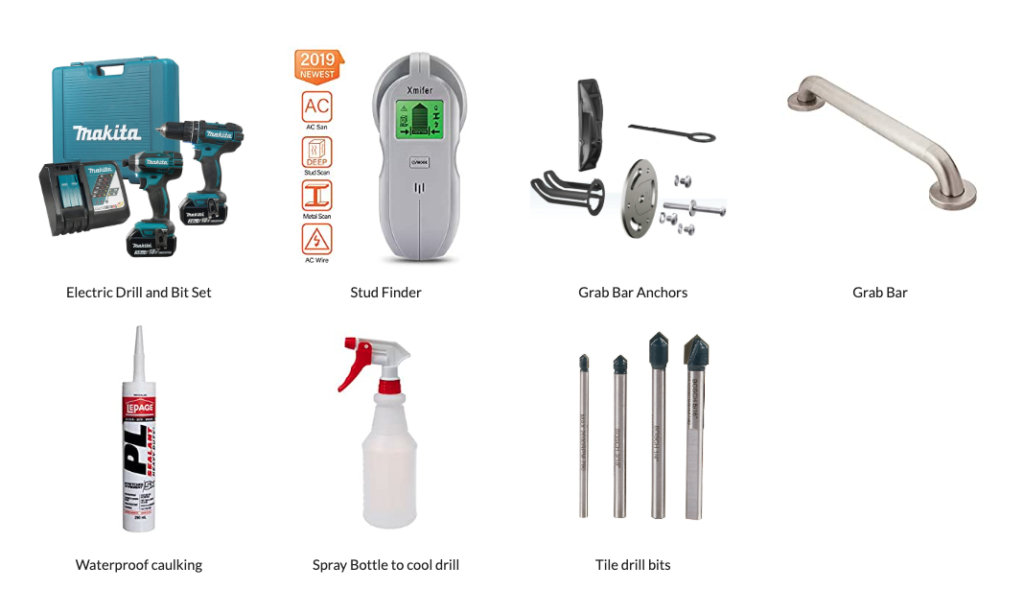
Conclusion
This study emphasizes the importance of grab bar placement in ensuring senior safety. Thoughtful configurations tailored to user needs can significantly reduce the risk of bathroom falls and improve overall confidence and comfort.